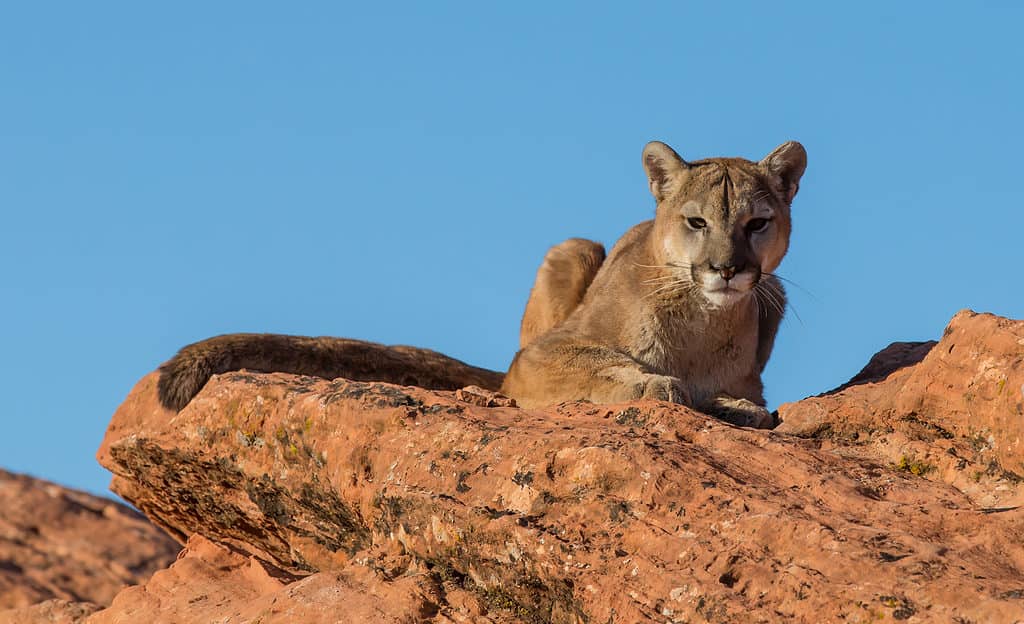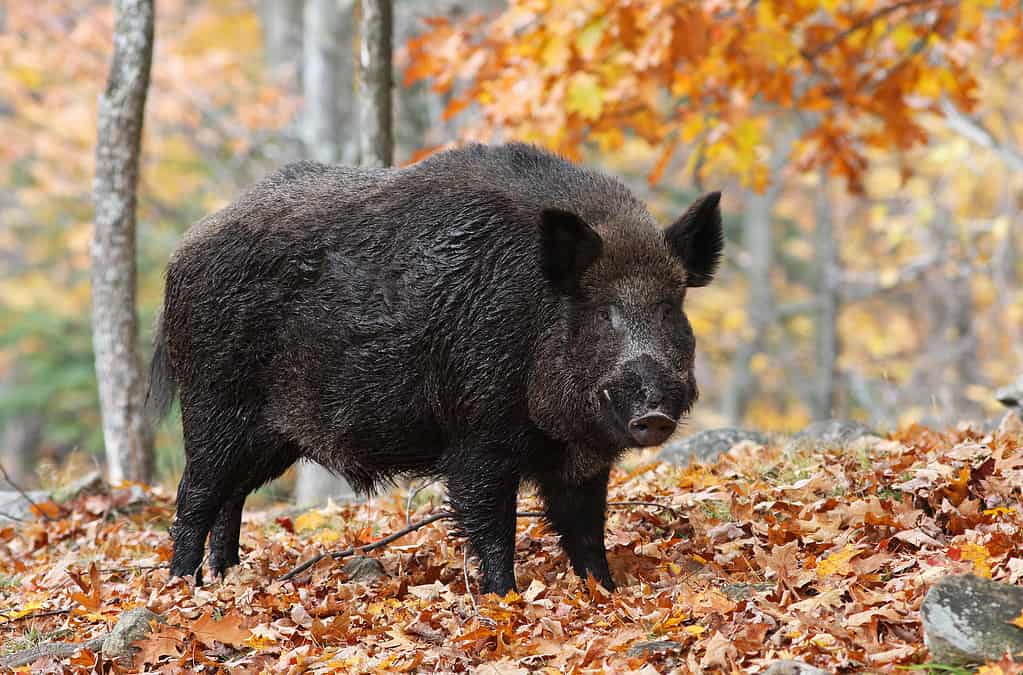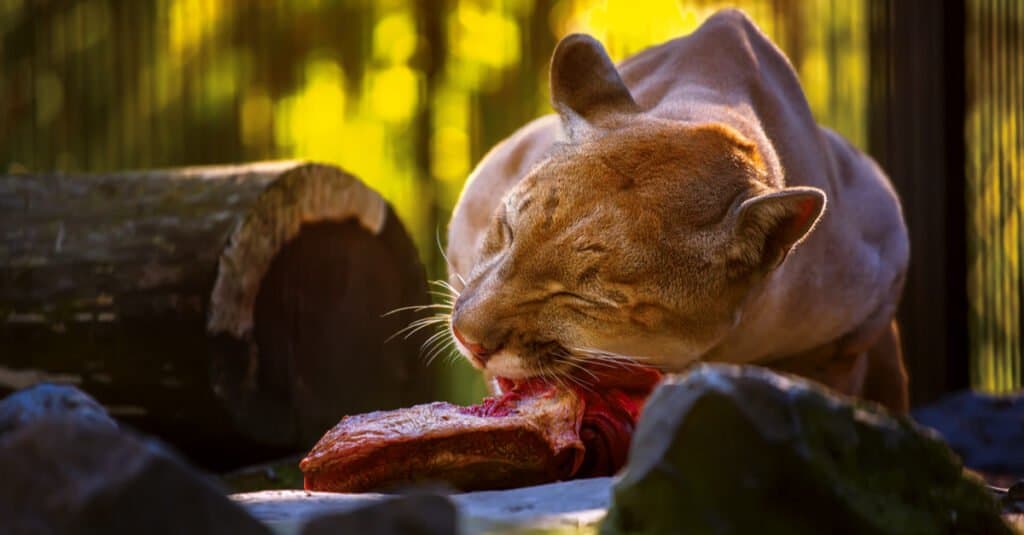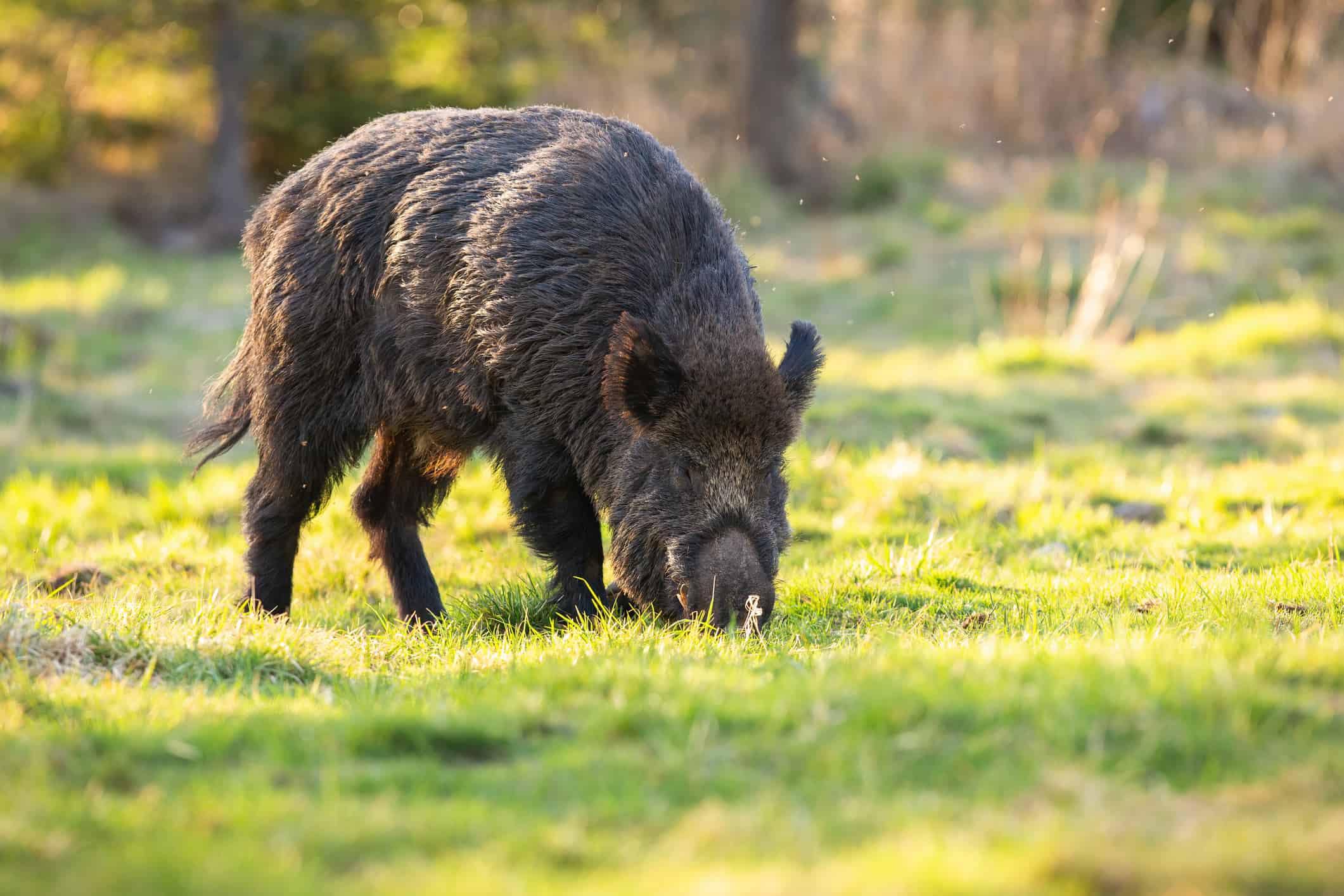Welcome to a Texas showdown: the mountain lion vs. feral hog. On one side, we have the mountain lion, a majestic predator rare to see in the wild. On the other side, we have the feral hog, an invasive species that Texans would love to see leave for good!
Both contenders are strong and fast, making this face-off an intriguing battle of size, speed, attack, defense, intelligence, and survival skills. Follow along as we explore each species’ attributes and discover who emerges victorious in this epic battle.
Main Points: Mountain Lion vs. Feral Hog
- Mountain lions are also known as cougars, pumas, and panthers.
- Feral hogs, or wild boars, are an invasive species causing problems in Texas.
- Mountain lions are faster than hogs, reaching speeds up to 50 mph.
- Mountain lions have powerful jaws and sharp claws, while feral hogs use sharp tusks and aggressive behavior.
- Mountain lions can grow much larger than hogs. Here is the biggest mountain lion ever caught in Texas.
- Mountain lion hotspots include the Guadalupe Mountains, Big Bend National Park, and more.
- Feral hogs are found in most counties in Texas, especially in the East, South, and Central regions.
- Feral hogs have been sighted in Lake Somerville, Caddo Lake, and Pedernales Falls State Parks.
- Feral hogs have a detrimental effect on the environment. Their rooting behavior damages vegetation, disrupts soil, and harms native plant and animal species.
- Texans for Mountain Lions, in collaboration with Texas Parks and Wildlife, work to protect mountain lions and their habitats. Through conservation initiatives and awareness campaigns, they strive to ensure the long-term survival of these majestic creatures in Texas.
Get ready for an exciting animal battle in the Lone Star State! Let’s start by closely examining our first competitor, the mountain lion.
Competitor #1: Mountain Lion

Male mountain lions typically weigh between 110 to 232 pounds.
©Warren Metcalf/Shutterstock.com
Mountain lions have many names! In the Western part of the United States, they’re often called mountain lions, but they’re also known as cougars, pumas, and panthers. Male mountain lions typically weigh between 110 to 232 pounds, while females are a bit smaller, weighing between 79 to 132 pounds. The mountain lions in Texas are usually on the smaller end of the scale.
These big cats are amazing climbers and jumpers. They can leap forward as far as 20 feet and jump up to 15 feet high in the air. Males like to roam territories covering 75 to 150 square miles, and sometimes even more. Females usually stay within a smaller area of 24 to 50 square miles, often in areas close to where their mothers live.
Saving Mountain Lions
Texas has two main groups of mountain lions, one in the west and another in the South. The group in West Texas is doing well because new mountain lions keep coming in from Mexico and New Mexico. The group in South Texas could be doing better, mostly because people keep building in their habitat. Thankfully a group called Texans for Mountain Lions is working with Texas Parks and Wildlife to devise a plan to protect mountain lions throughout the state.
Competitor #2: Feral Hog

Feral hogs are an invasive species with a lot of numbers in Texas.
©Mircea Costina/Shutterstock.com
Our second competitor, the invasive feral hog, is an unwanted guest in Texas. These pigs are dangerous and messy. They dig holes in the ground looking for food, which can mess up the soil and cause other problems like damaging dams.
The Texas Wildlife Services group works together to help control the wild pig population. They set up traps and hunt pigs using night vision goggles and even helicopters. Private landowners are also lending a hand, helping to reclaim the land for the state’s native species.
Wild pigs aren’t native to North America. European explorers brought them over hundreds of years ago, and they’ve been multiplying ever since. Since they reproduce so prolifically, controlling the wild pig population in Texas is a big job. Let’s see if our mountain lion challenger will have what it takes to eliminate one of these wild pig’s from the state’s numbers.
Mountain Lion vs. Feral Hog: Key Factors
In a mountain lion vs. feral hog battle, the key factors are size, speed, attack, defense, intelligence, and survival skills.
Animal matchups are all about discovering which species can gain enough advantage to win. Sometimes, the comparisons are insane, like seeing what happens when a bald eagle tries to take down a mountain lion. For today’s match-up, the hog might stand a fighting chance; they have some impressive numbers regarding size. Let’s see how these stats will help them during a face-off with a mountain lion!
Round 1: Size and Speed

Feral hogs can charge at a speed of 30 mph.
©Martin Mecnarowski/Shutterstock.com
Mountain Lion:
- Adult male weight: 117 to 220 pounds
- Adult female weight: 75 to 141 pounds
- Length: 59 feet (including tail)
- Speed: Up to 50 mph
Feral Hog:
- Adult weight: 100 to 400 pounds
- Length: 46 feet (including tail)
- Speed: Up to 30 mph
Differences in size and speed are sizable in comparing the mountain lion and feral hog. Male mountain lions typically weigh between 117 to 220 pounds and span 59 feet long, tail included. In rare cases, they can grow larger. Females are slightly smaller, weighing 70 to 141 pounds. Male or female, these lions can reach impressive speeds of up to 50 mph.
On the other hand, feral hogs can get pretty big too. They weigh anywhere from 100 to a substantial 400 pounds, and their length is between 4 to 6 feet. However, their speed peaks at about 30 mph, considerably slower than the mountain lion.
Round 2: Attack and Defense Tactics

Mountain lions use their powerful jaws to deliver a fatal bite to the neck of their prey.
©Ipatov/Shutterstock.com
Mountain Lion:
- Attack: Powerful jaws, sharp claws
- Defense: Agility, tree climbing ability
Feral Hog:
- Attack: Sharp tusks, charge attack
- Defense: Tough hide, aggressive behavior when threatened
Regarding attack and defense, both animals possess unique strengths. Mountain lions use their powerful jaws to deliver a fatal bite to the neck of their prey. They rely on their powerful jaws and sharp claws, which are essential for hunting and defense. Their agility also serves as a defense, as they can quickly climb trees to evade threats.
On the flip side, feral hogs have sharp tusks made for slashing. They can perform a charge attack when threatened. Their tough hide is natural armor, and their rhino-like attitude can deter predators. Hogs are known to charge first and ask questions later.
Round 3: Intelligence and Survival Skills

Feral hogs have an excellent sense of smell, helping them root out food in the ground.
©iStock.com/sus scrofa
Mountain Lion:
- Intelligence: Demonstrates problem-solving abilities
- Survival Skills: Excellent at stealth, strong swimmer, adapts to varied habitats
Feral Hog:
- Intelligence: Known for being intelligent and adaptable
- Survival Skills: Excellent sense of smell, survives in different environments, nocturnal behavior adds protection
Regarding intelligence and survival skills, mountain lions and feral hogs show remarkable talent. Mountain lions exhibit problem-solving abilities, indicating high intelligence. Their survival skills are equally impressive. These felines get an A+ and excel in stealth, swimming, and adaptability.
Although not as predatory as mountain lions, feral hogs are noted for their intelligence and adaptability. They possess a strong sense of smell, which is beneficial for foraging. They can also use their sense of smell to sniff out predators. This invasive species can thrive in different environments, and their nocturnal lifestyle helps keep them safe from certain threats.
Where Do Mountain Lions Live in Texas?

Mountain lions live throughout the forests of Texas.
©Hundley Photography/Shutterstock.com
Where is this animal battle taking place? Let’s look at some of the places our showdown could happen:
Here are a few of mountain lion hot spots:
- Guadalupe Mountains National Park: The rugged landscape and plentiful wildlife make this area a perfect habitat for mountain lions.
- Big Bend National Park: Known for its wide range of wildlife, Big Bend offers a large food supply and rugged terrain that mountain lions prefer.
- Davis Mountains State Park: This park provides the sort of rocky, remote habitat that mountain lions favor, with plenty of deer to prey on.
- Palo Duro Canyon State Park: The second largest canyon in the United States, this area’s high cliffs and deep valleys are well suited to mountain lions.
- Padre Island National Seashore: While it might seem surprising, mountain lions have been spotted in this coastal region, likely due to the abundance of small mammals.
- Hill Country State Natural Area: This area is known for its rugged hills, canyons, and grasslands, providing excellent cover and abundant prey for mountain lions.
- Balcones Canyonlands National Wildlife Refuge: This wildlife refuge hosts diverse fauna, including a healthy population of white-tailed deer, making it a suitable habitat for mountain lions.
- Sam Houston National Forest: Great habitat for a variety of wildlife, including mountain lions.
- The Chisos Mountains in Big Bend National Park: Rugged, rocky terrain that mountain lions often call home.
Remember, mountain lions are elusive and solitary by nature, so even in these areas, sightings can be rare.
Where Are the Feral Hogs in Texas?
Texas is home to about 3 million wild hogs! They can be found in 253 out of the 254 counties in the state. Most wild hogs in Texas live in the state’s East, South, and Central parts. They like to live in the same places as white-tailed deer, which happens to be a mountain lion’s favorite meal.
In the summer, wild hogs like to hang out in muddy, wet areas. They never go too far from places with lots of plants where they can hide. These hogs prefer places like humid pine woods in the East and brushy areas in the South.
Feral hogs take up a lot of space. The amount of food and places to hide decide how big of an area the wild hogs will call home. Sometimes their home range can cover up to 70,000 acres — but it’s usually less than 5,000 acres.
Feral Hog Sightings
There are a lot of places a mountain lion could run into a feral hog. Lake Somerville State Park near Brenham has feral hog problems. Caddo Lake State Park in East Texas has feral hogs rummaging around the bayous and bald cypress trees. And Pedernales Falls State Park in Johnson City has hog sightings. These are just a few places in Texas where our animal battle could occur.
Who Wins?
The mountain lion is the winner. They have more options when it comes to choosing how they move. Leaping, pouncing, and crouching, mountain lions are agile beasts.
An animal matchup between a mountain lion and a feral hog would hinge on various factors, such as the animals’ age, size, health, and environment. However, given the mountain lion’s faster speed, agility, and hunting instincts, it would have an advantage in a one-on-one encounter.
Nature can be unpredictable, and no confrontation’s outcome can be entirely assured. It’s possible a feral hog could pull a fast one on an unsuspecting mountain lion, like a juvenile cat. But going toe-to-toe with a full-grown adult mountain lion, the big pig doesn’t stand a chance. For this Texas showdown, the mountain lion is the clear winner.
Possible Battle Scenarios
How would the animal battle play out? There are a few different scenarios we’ve dreamed up.
- Ambush: The mountain lion silently stalks and pounces on the feral hog, overpowering it.
- Charge Attack: The aggressive feral hog charges at the mountain lion, but the lion’s agility allows it to dodge and counterattack.
- Battle of Defenses: The tough hide of the feral hog withstands initial attacks, but the mountain lion’s strength eventually overpowers it.
- Retreat: The intelligent feral hog retreats to safer grounds to avoid direct confrontation with the mountain lion.
The photo featured at the top of this post is ©
Thank you for reading! Have some feedback for us? Contact the AZ Animals editorial team.







